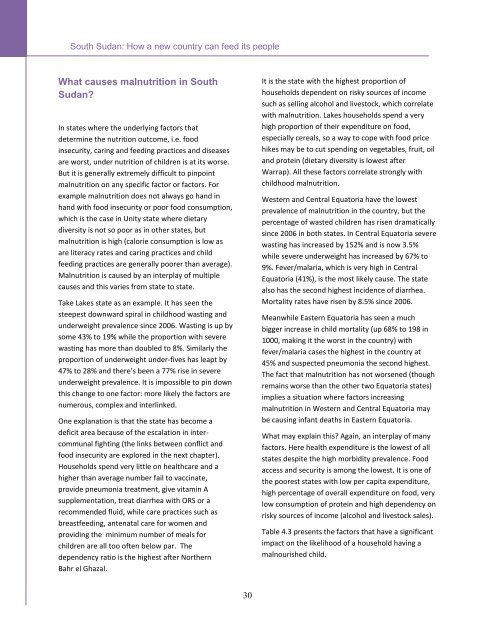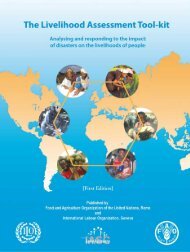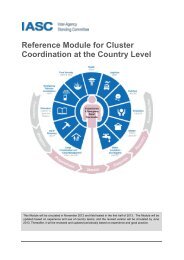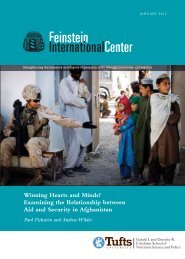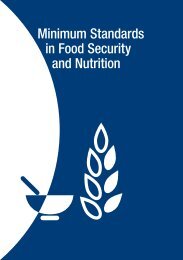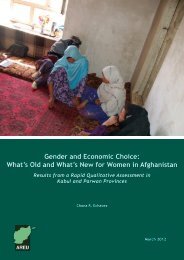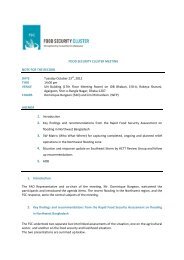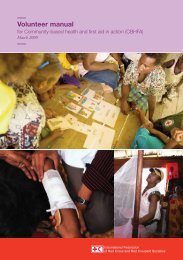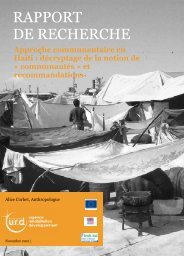4.15 MB - Food Security Clusters
4.15 MB - Food Security Clusters
4.15 MB - Food Security Clusters
- No tags were found...
You also want an ePaper? Increase the reach of your titles
YUMPU automatically turns print PDFs into web optimized ePapers that Google loves.
South Sudan: How a new country can feed its peopleWhat causes malnutrition in SouthSudan?In states where the underlying factors thatdetermine the nutrition outcome, i.e. foodinsecurity, caring and feeding practices and diseasesare worst, under nutrition of children is at its worse.But it is generally extremely difficult to pinpointmalnutrition on any specific factor or factors. Forexample malnutrition does not always go hand inhand with food insecurity or poor food consumption,which is the case in Unity state where dietarydiversity is not so poor as in other states, butmalnutrition is high (calorie consumption is low asare literacy rates and caring practices and childfeeding practices are generally poorer than average).Malnutrition is caused by an interplay of multiplecauses and this varies from state to state.Take Lakes state as an example. It has seen thesteepest downward spiral in childhood wasting andunderweight prevalence since 2006. Wasting is up bysome 43% to 19% while the proportion with severewasting has more than doubled to 8%. Similarly theproportion of underweight under-fives has leapt by47% to 28% and there’s been a 77% rise in severeunderweight prevalence. It is impossible to pin downthis change to one factor: more likely the factors arenumerous, complex and interlinked.One explanation is that the state has become adeficit area because of the escalation in intercommunalfighting (the links between conflict andfood insecurity are explored in the next chapter).Households spend very little on healthcare and ahigher than average number fail to vaccinate,provide pneumonia treatment, give vitamin Asupplementation, treat diarrhea with ORS or arecommended fluid, while care practices such asbreastfeeding, antenatal care for women andproviding the minimum number of meals forchildren are all too often below par. Thedependency ratio is the highest after NorthernBahr el Ghazal.It is the state with the highest proportion ofhouseholds dependent on risky sources of incomesuch as selling alcohol and livestock, which correlatewith malnutrition. Lakes households spend a veryhigh proportion of their expenditure on food,especially cereals, so a way to cope with food pricehikes may be to cut spending on vegetables, fruit, oiland protein (dietary diversity is lowest afterWarrap). All these factors correlate strongly withchildhood malnutrition.Western and Central Equatoria have the lowestprevalence of malnutrition in the country, but thepercentage of wasted children has risen dramaticallysince 2006 in both states. In Central Equatoria severewasting has increased by 152% and is now 3.5%while severe underweight has increased by 67% to9%. Fever/malaria, which is very high in CentralEquatoria (41%), is the most likely cause. The statealso has the second highest incidence of diarrhea.Mortality rates have risen by 8.5% since 2006.Meanwhile Eastern Equatoria has seen a muchbigger increase in child mortality (up 68% to 198 in1000, making it the worst in the country) withfever/malaria cases the highest in the country at45% and suspected pneumonia the second highest.The fact that malnutrition has not worsened (thoughremains worse than the other two Equatoria states)implies a situation where factors increasingmalnutrition in Western and Central Equatoria maybe causing infant deaths in Eastern Equatoria.What may explain this? Again, an interplay of manyfactors. Here health expenditure is the lowest of allstates despite the high morbidity prevalence. <strong>Food</strong>access and security is among the lowest. It is one ofthe poorest states with low per capita expenditure,high percentage of overall expenditure on food, verylow consumption of protein and high dependency onrisky sources of income (alcohol and livestock sales).Table 4.3 presents the factors that have a significantimpact on the likelihood of a household having amalnourished child.30


